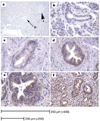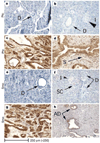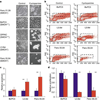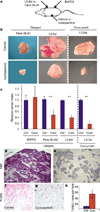Hedgehog is an early and late mediator of pancreatic cancer tumorigenesis
- PMID: 14520413
- PMCID: PMC3688051
- DOI: 10.1038/nature02009
Hedgehog is an early and late mediator of pancreatic cancer tumorigenesis
Abstract
Hedgehog signalling--an essential pathway during embryonic pancreatic development, the misregulation of which has been implicated in several forms of cancer--may also be an important mediator in human pancreatic carcinoma. Here we report that sonic hedgehog, a secreted hedgehog ligand, is abnormally expressed in pancreatic adenocarcinoma and its precursor lesions: pancreatic intraepithelial neoplasia (PanIN). Pancreata of Pdx-Shh mice (in which Shh is misexpressed in the pancreatic endoderm) develop abnormal tubular structures, a phenocopy of human PanIN-1 and -2. Moreover, these PanIN-like lesions also contain mutations in K-ras and overexpress HER-2/neu, which are genetic mutations found early in the progression of human pancreatic cancer. Furthermore, hedgehog signalling remains active in cell lines established from primary and metastatic pancreatic adenocarcinomas. Notably, inhibition of hedgehog signalling by cyclopamine induced apoptosis and blocked proliferation in a subset of the pancreatic cancer cell lines both in vitro and in vivo. These data suggest that this pathway may have an early and critical role in the genesis of this cancer, and that maintenance of hedgehog signalling is important for aberrant proliferation and tumorigenesis.
Figures





Comment in
-
Cancer: a twist in a hedgehog's tale.Nature. 2003 Oct 23;425(6960):780-2. doi: 10.1038/425780a. Nature. 2003. PMID: 14574396 No abstract available.
-
[A essential gen in the development of pancreatic carcinogenesis].Acta Gastroenterol Latinoam. 2005;35(2):141-3. Acta Gastroenterol Latinoam. 2005. PMID: 16733883 Spanish. No abstract available.
References
-
- Hardcastle Z, Mo R, Hui C-C, Sharpe PT. The Shh signalling pathway in tooth development: defects in Gli2 and Gli3 mutants. Development. 1998;125:2803–2811. - PubMed
-
- Riddle RD, Johnson RL, Laufer E, Tabin C. Sonic hedgehog mediates the polarizing activity of the ZPA. Cell. 1993;75:1401–1416. - PubMed
-
- St-Jacques B, et al. Sonic hedgehog signaling is essential for hair development. Curr. Biol. 1998;8:1058–1068. - PubMed
Publication types
MeSH terms
Substances
Grants and funding
LinkOut - more resources
Full Text Sources
Other Literature Sources
Medical
Molecular Biology Databases
Research Materials
Miscellaneous

